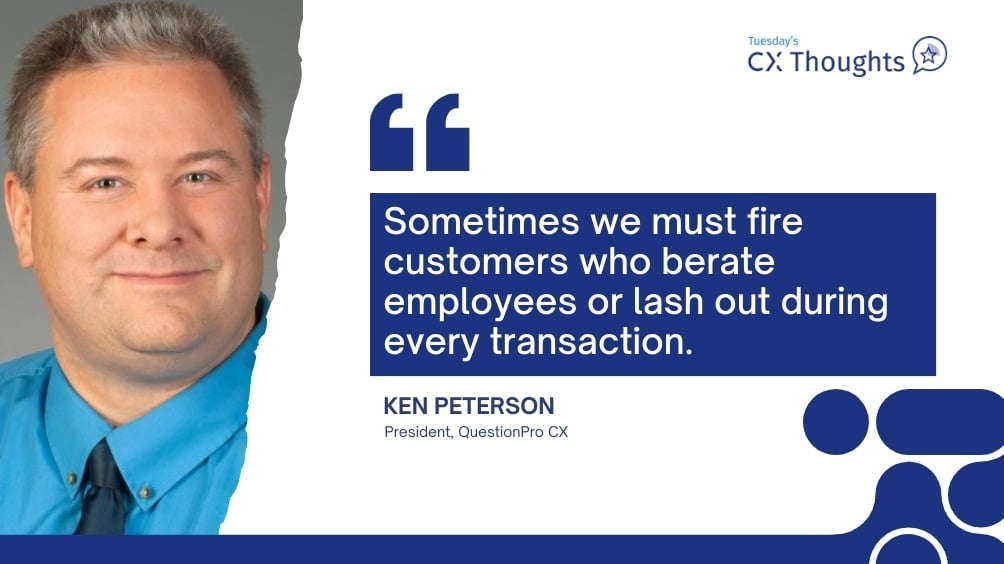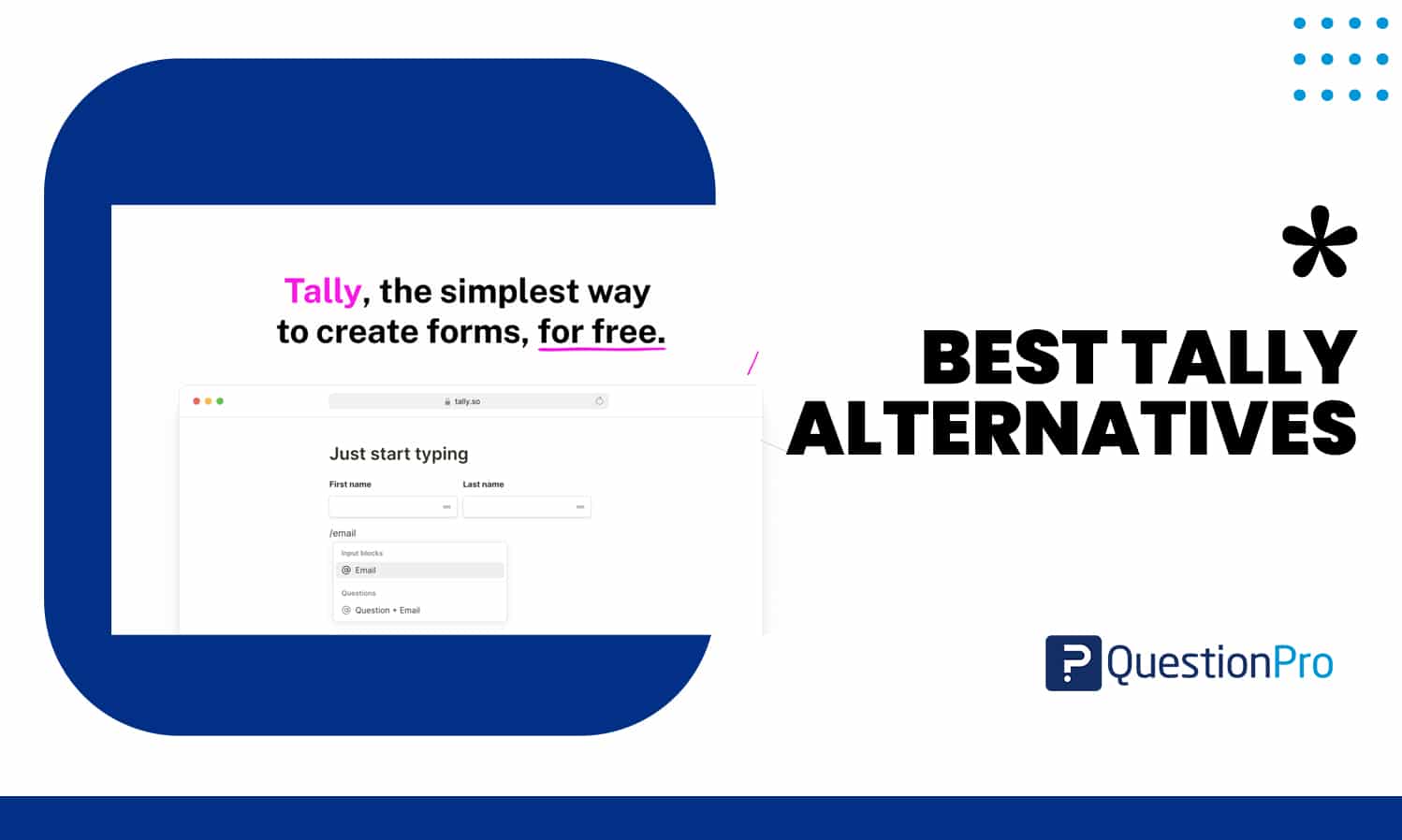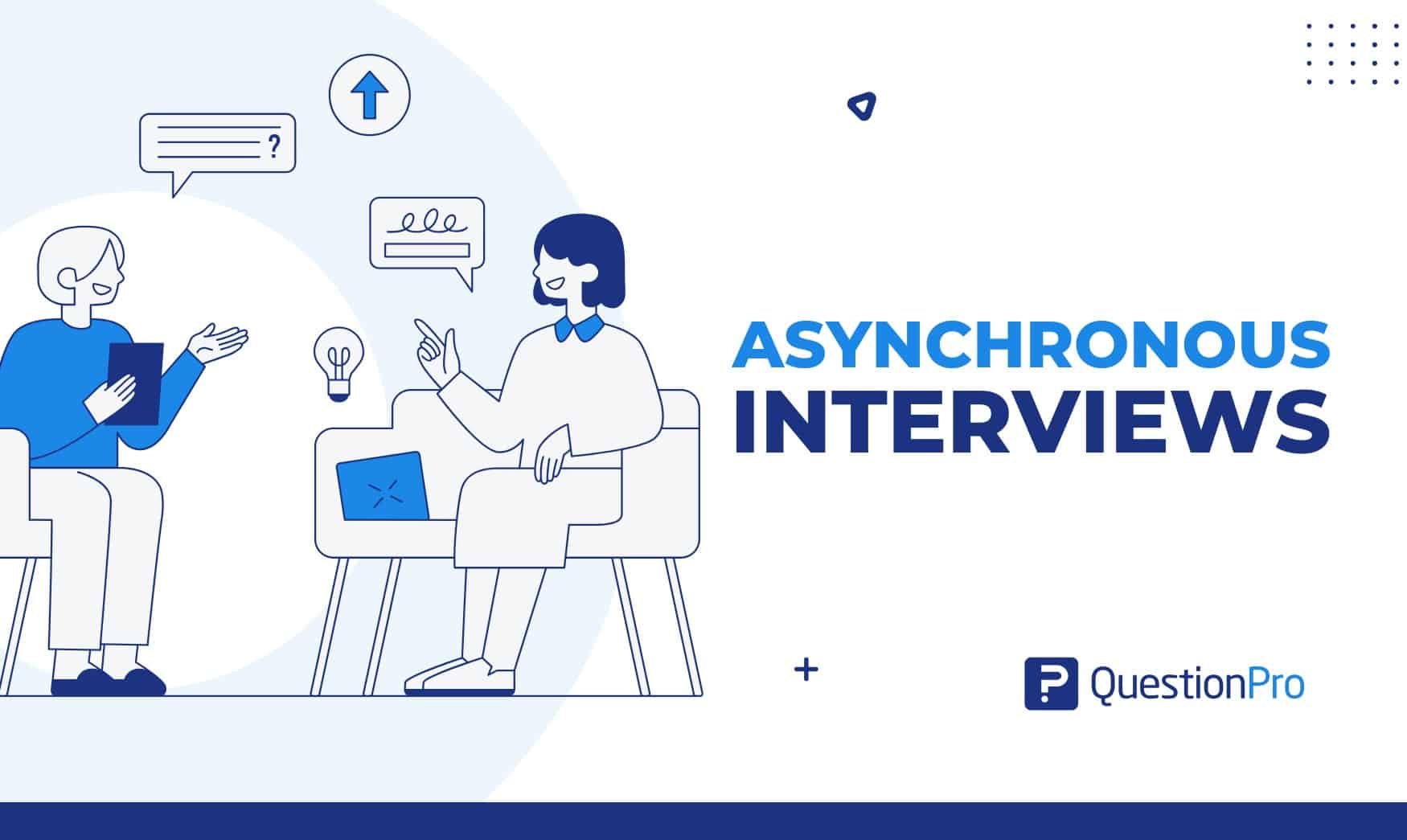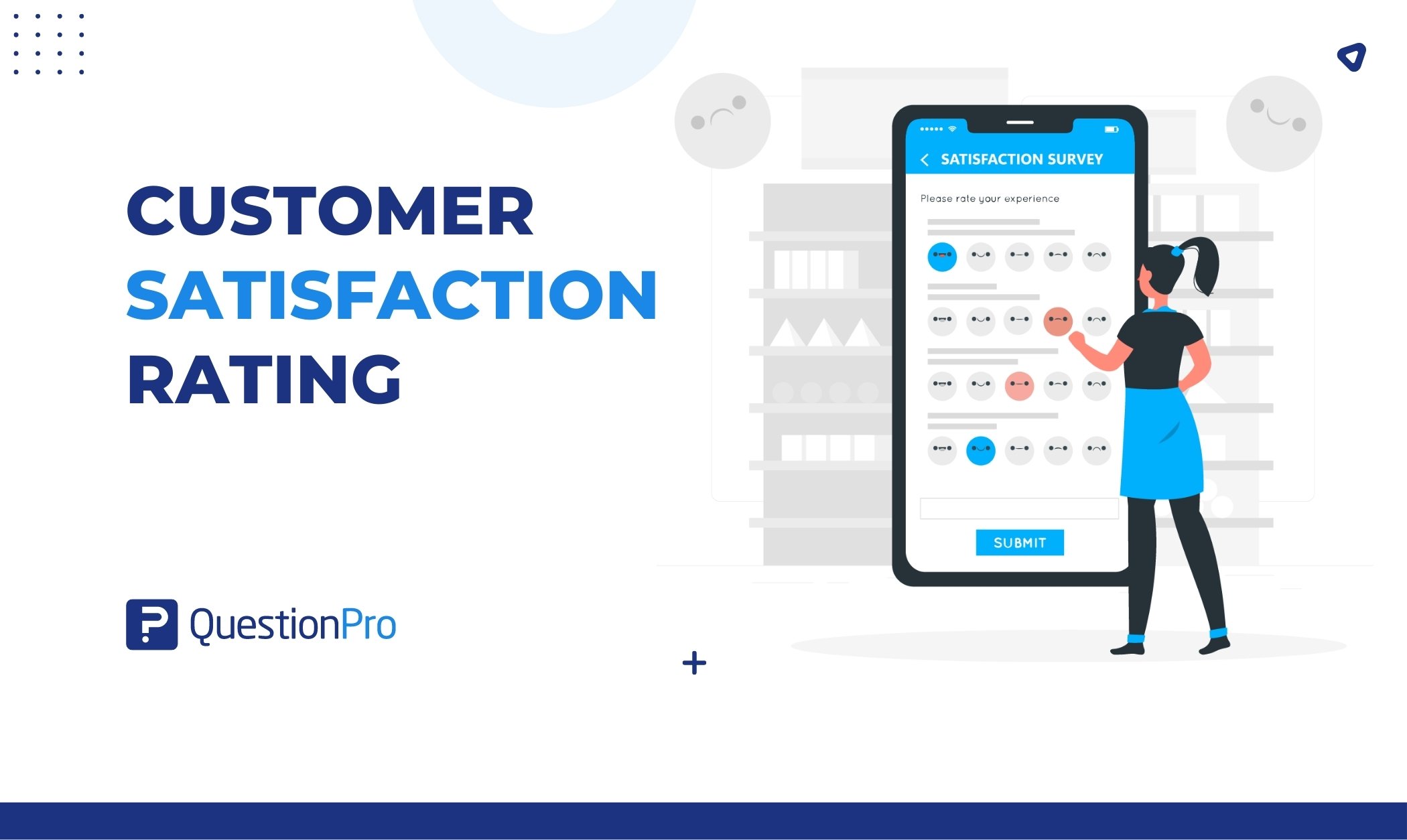
การให้คะแนนความพึงพอใจของลูกค้ามักใช้เพื่อคาดการณ์ความสําเร็จหรือความล้มเหลวของโปรแกรมการจัดการลูกค้าสัมพันธ์ของแบรนด์
ลูกค้าสามารถส่งข้อเสนอแนะได้เมื่อตั๋วได้รับการแก้ไขแล้วโดยกรอกแบบสํารวจสั้น ๆ โดยมีสองตัวเลือก: คะแนนเชิงบวกหรือเชิงลบ
การให้คะแนน CSAT เป็นวิธีที่ยอดเยี่ยมในการประเมินประสิทธิภาพของพนักงานของคุณ และอาจควบคุมได้อย่างเหมาะสมด้วยระบบติดตามความพึงพอใจของแขก
หากคุณต้องการเรียนรู้เพิ่มเติมเกี่ยวกับหัวข้อนี้ คุณมาถูกที่แล้ว! ในบทความนี้ เราจะกล่าวถึง CSAT คืออะไร และยังให้วิธีวัดเพื่อเริ่มปรับปรุงความสัมพันธ์ของคุณกับลูกค้า
คะแนนความพึงพอใจของลูกค้า (CSAT Rating) คืออะไร?
คะแนนความพึงพอใจของลูกค้าหรือคะแนน CSAT เป็นตัวชี้วัดที่บ่งชี้ว่าผลิตภัณฑ์และบริการของคุณตอบสนองความคาดหวังของลูกค้าได้ดีเพียงใด
คะแนนความพึงพอใจของลูกค้าเป็นหนึ่งในวิธีที่ง่ายที่สุดใน การวัดความพึงพอใจของลูกค้า วัด ความสุขของลูกค้า สําหรับประสบการณ์การซื้อ คุณภาพของปฏิสัมพันธ์ ฯลฯ
การวัดระดับความพึงพอใจของลูกค้าผ่านแบบสํารวจที่กําหนดเองจะช่วยให้ทราบว่าทีมสนับสนุนลูกค้าของคุณทํางานได้ดีเพียงใด การบริการลูกค้า ที่ยอดเยี่ยมช่วยให้มั่นใจได้ว่าลูกค้าพึงพอใจและภักดีต่อแบรนด์ของคุณ คําถามคะแนน CSAT สามารถปรับแต่งให้พิจารณาในแง่มุมต่างๆ และทําความเข้าใจว่าอะไรใช้ได้ผลและอะไรไม่ได้ผล
ความเก่งกาจนี้คือเหตุผลที่นักวิจัยตลาดชอบคําถาม CSAT โดยทั่วไปจะวัดโดยการถามลูกค้าของคุณว่า ‘คุณพอใจกับบริการของเรามากแค่ไหน’ หรือ ‘คุณพอใจกับประสบการณ์การซื้อมากน้อยเพียงใด’ เป็นต้น คําตอบจะถูกบันทึกไว้ในระดับการให้คะแนน 1 – 3, 1 – 5 หรือ 1 – 10

นักวิจัยตลาดมักจะชอบมาตราส่วนห้าจุด โดยให้คะแนน 1 สําหรับ ‘ไม่พอใจมากหรือมาก’ และ 5 สําหรับ ‘พอใจมากหรือมาก’ การเลือกของผู้ตอบแบบสอบถามจากตัวเลือกคือเมตริกที่รายงาน การตั้งค่าแต่ละรายการจะถูกเพิ่มและลงทะเบียนเป็นเปอร์เซ็นต์ของคําตอบทั้งหมดหารด้วยกรอบเวลาที่กําหนดในระดับรวม
มี จุดสัมผัส ของลูกค้าที่หลากหลายในการเดินทางของลูกค้า คุณมีจุดสัมผัสก่อนซื้อ ระหว่างการซื้อ และหลังการซื้อ ทําให้ประสบการณ์ของลูกค้าที่ราบรื่นเป็นเรื่องท้าทาย
เหตุใดการจัดอันดับ CSAT จึงมีความสําคัญ
ความคิดเห็นของลูกค้าที่รวบรวมช่วยให้คุณเข้าใจสิ่งที่คุณอาจพลาดไปในการมอบ ประสบการณ์ที่ยอดเยี่ยมให้กับลูกค้า แบบสํารวจ CSAT ช่วยให้คุณทําเช่นนั้นได้
การใช้การจัดอันดับ CSAT ในแบบสํารวจออนไลน์ของคุณเป็นสิ่งสําคัญ เนื่องจากช่วยให้แบรนด์และองค์กรสามารถ:
Customer loyalty and retention
คะแนนความพึงพอใจของลูกค้าที่สูงแสดงให้เห็นว่าลูกค้าพอใจกับประสบการณ์ของพวกเขา ซึ่งสามารถนําไปสู่การเชื่อมต่อในระยะยาวและมูลค่าตลอดอายุการใช้งานของลูกค้าที่มากขึ้น
ลูกค้าที่พึงพอใจกับผลิตภัณฑ์หรือบริการของแบรนด์มีแนวโน้มที่จะยึดติดกับผลิตภัณฑ์หรือบริการนั้นมากกว่า พวกเขายังมีแนวโน้มที่จะกลายเป็นลูกค้าประจํา ซึ่งเพิ่มอัตราการรักษาลูกค้า
การรักษาและสร้างความภักดีของลูกค้าจะเป็นสูตรสําเร็จเสมอ โดยเฉพาะอย่างยิ่งเมื่อพิจารณาว่าการหาลูกค้าใหม่มีค่าใช้จ่ายมากกว่า ซึ่งเป็นแนวโน้มที่ไม่มีสัญญาณว่าจะชะลอตัวลง
จากข้อมูลของ Stuart Crowley คุณรู้หรือไม่ว่าต้นทุนการได้มาซึ่งลูกค้าของลูกค้าใหม่เพิ่มขึ้น 60% ในช่วง 5 ปีที่ผ่านมา!
Customer feedback and improvement opportunities
การคํานวณและทราบคะแนนความพึงพอใจของลูกค้าของคุณนั้นเป็นมากกว่าบางสิ่งที่มีคุณภาพ แต่ยังเป็นโอกาสที่ดีที่จะทราบข้อเสนอแนะและความคิดเห็นเฉพาะของพันธมิตรที่ดีที่สุดที่คุณมีในธุรกิจของคุณ: ลูกค้าของคุณ
ธุรกิจสามารถค้นพบ จุดบกพร่องเฉพาะ แก้ปัญหาของลูกค้า และทําการปรับปรุงอย่างมุ่งเน้นเพื่อปรับปรุงประสบการณ์โดยรวมของลูกค้าโดยการประเมินการให้คะแนนและทําความเข้าใจความคิดเห็นของลูกค้า
Increased customer engagement
แบบสํารวจ CSAT แบบสํารวจ CSAT ช่วยเพิ่มการมีส่วนร่วมของแบรนด์ เนื่องจากสามารถกลายเป็นแหล่งข้อมูลที่มีค่าในการกระชับความสัมพันธ์กับฐานผู้บริโภคปัจจุบันของคุณ การทําให้พวกเขารู้สึกว่าได้ยินและดําเนินการตามข้อเสนอแนะ เป็นไปได้ที่จะเปลี่ยนพวกเขาให้เป็นโปรโมเตอร์
ผู้สนับสนุนแบรนด์มีแนวโน้มที่จะโต้ตอบกับแบรนด์ส่งข้อเสนอแนะเข้าร่วมโปรแกรมความภักดีและมีส่วนร่วมในการสนทนาทางโซเชียลมีเดียในเชิงบวก
Customer-centric focus
การวัดคะแนนความพึงพอใจของลูกค้าช่วยให้ธุรกิจมุ่งเน้นลูกค้า
การวางลูกค้าของคุณเป็นศูนย์กลางของการดําเนินธุรกิจของคุณสามารถช่วยกระชับความสัมพันธ์สร้างความไว้วางใจและเพิ่มความพึงพอใจของพวกเขา ประโยชน์หลายอย่างเหล่านี้มักจะขยายออกไปนอกเหนือจากคุณภาพของผลิตภัณฑ์หรือบริการที่คุณนําเสนอ:
ธุรกิจที่ดีคือธุรกิจที่ทุ่มเทเพื่อทําความเข้าใจและตอบสนองความต้องการของลูกค้าโดยให้ความสําคัญกับ ความสุขของลูกค้า กลยุทธ์ที่เน้นลูกค้าเป็นศูนย์กลางนี้เสริมสร้างการเชื่อมต่อสร้างความไว้วางใจและปรับปรุง CSAT โดยรวม
หากคุณต้องการเรียนรู้เพิ่มเติมเกี่ยวกับหัวข้อที่เกี่ยวข้อง เราขอแนะนําให้อ่าน: การจัดการลูกค้า
ประเภทของเครื่องชั่งการให้คะแนนความพึงพอใจของลูกค้า
มาตราส่วนการให้คะแนนช่วยวัด KPI ความพึงพอใจของลูกค้าได้อย่าง แม่นยําใน แบบสอบถามความพึงพอใจของลูกค้าออนไลน์ นักวิจัยสามารถใช้มาตราส่วนการให้คะแนนสาม ห้า เจ็ด สิบ และสิบเอ็ดคะแนน การเลือกมาตราส่วนการให้คะแนนขึ้นอยู่กับประเภทและจุดเน้นของการวิจัยที่ดําเนินการ
ด้านล่างนี้ คุณสามารถเรียนรู้เพิ่มเติมเกี่ยวกับเครื่องชั่งแต่ละเครื่องเพื่อเลือกเครื่องชั่งที่เหมาะกับความต้องการของคุณมากที่สุด
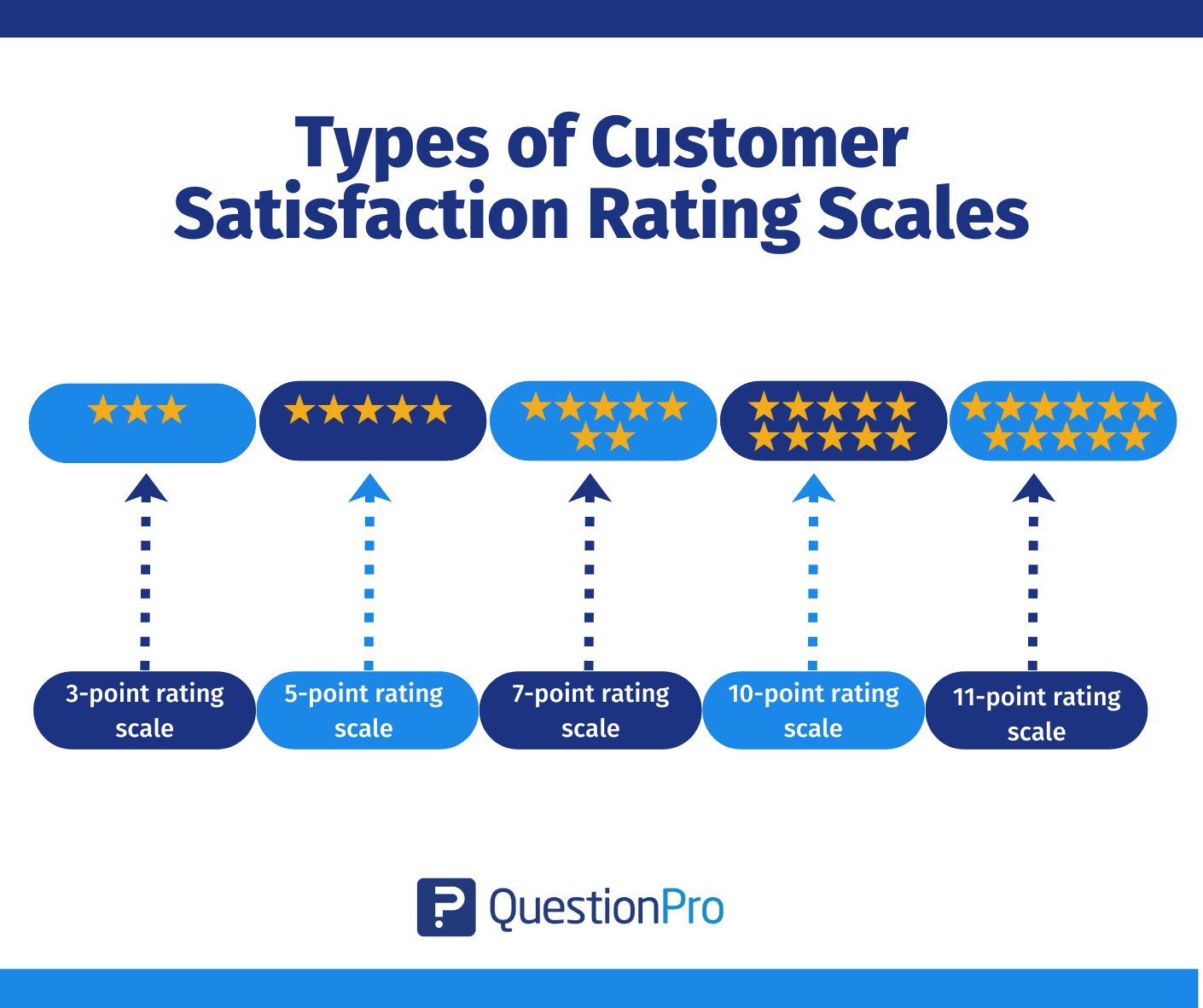
มาตราส่วนการให้คะแนน 3 จุด
มาตราส่วนนี้ใช้เมื่อมีข้อจํากัดเกี่ยวกับพื้นที่ภาพ ช่วยรวบรวมข้อมูลที่เกี่ยวข้องจากผู้ตอบแบบสอบถามของคุณและดึงดูดสายตา
แบบสํารวจที่รกนั้นไม่เหมาะสมและมีอัตราการตอบกลับและอัตราการทําแบบสํารวจที่ต่ํามาก ใช้คําถาม แบบสํารวจความพึงพอใจของลูกค้า อย่างง่ายเพื่อปรับปรุงอัตราการตอบกลับและรวบรวมความคิดเห็นของลูกค้าสูงสุด
มาตราส่วนการให้คะแนน 5 จุด
นักวิจัยหลายคนชื่นชอบในด้านความน่าเชื่อถือ มาตราส่วน 5 จุดให้ผลลัพธ์ที่ยอดเยี่ยมด้วยสเกลขั้วเดียว เครื่องชั่งนี้มีประโยชน์ในการรวบรวมความคิดเห็นของลูกค้าเกี่ยวกับความพึงพอใจของลูกค้าที่มีต่อผลิตภัณฑ์และบริการใหม่
มาตราส่วนการให้คะแนน 7 จุด
นักวิจัยต้องการเท่าเทียมกันกับมาตราส่วน 5 จุด มาตราส่วนนี้ทํางานได้ดีที่สุดกับมาตราส่วนไบโพลาร์ มาตราส่วนการให้คะแนนนี้เหมาะอย่างยิ่งหากคุณวัดความพึงพอใจของลูกค้าสําหรับผลิตภัณฑ์หรือบริการที่เพิ่งเปิดตัว
มาตราส่วนการให้คะแนน 10 จุด
มาตราส่วน 10 จุดจะทํางานได้ดีที่สุดเมื่อมีจุดประสงค์เพื่อรวบรวมข้อมูลแบบละเอียด ในระดับนี้ 9 และ 10 บ่งบอกถึง ความพึงพอใจของลูกค้าโดยรวม นักวิจัยสามารถแยกแยะและพิจารณาเพิ่มเติมระหว่างการจัดอันดับทั้งสองเพื่อปรับแต่งกระบวนการของลูกค้า
มาตราส่วนการให้คะแนน 11 จุด
มาตราส่วนการให้คะแนนนี้วัด CSAT ตั้งแต่ 0-10 และใช้เมื่อลูกค้าพบว่าการให้คะแนนความพึงพอใจของตนได้ง่ายขึ้น องค์กรและนักวิจัยหลายแห่งทั่วโลกใช้มาตราส่วนการให้คะแนนนี้เนื่องจากช่วยแสดงความพึงพอใจได้แม่นยํายิ่งขึ้น
การให้คะแนนความพึงพอใจของลูกค้าทํางานอย่างไร
โดยปกติแล้ว การให้คะแนน CSAT จะทํางานโดยการรวบรวมความคิดเห็นของลูกค้าและใช้ข้อเสนอแนะนั้นเพื่อกําหนดความพึงพอใจ ต่อไปนี้เป็นขั้นตอนบางส่วนที่ต้องทําเพื่อเริ่มต้นใช้งาน CSAT ของคุณและใช้ประโยชน์สูงสุดจากมัน:
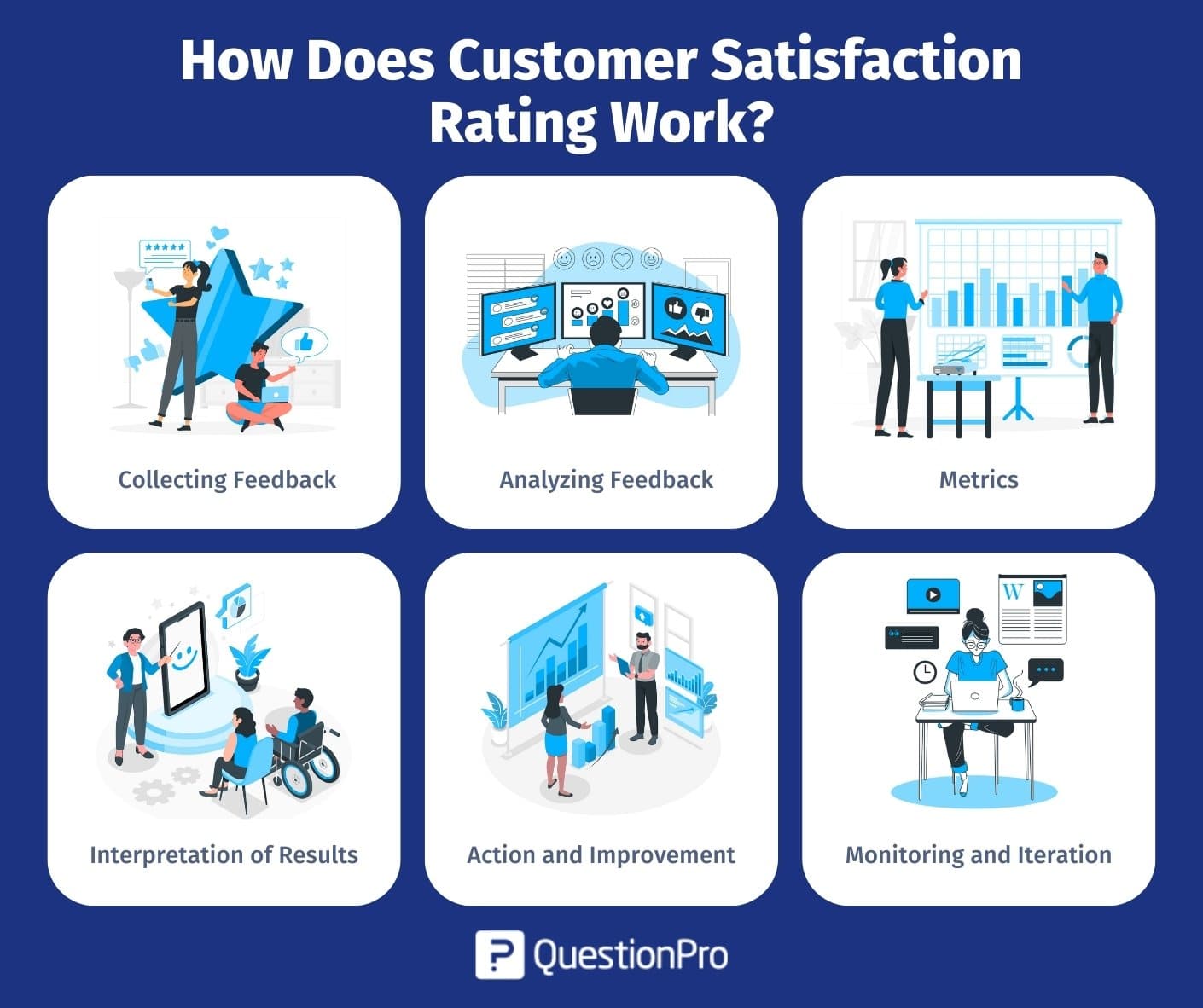
Collecting feedback
แบบสํารวจ แบบฟอร์มข้อเสนอแนะ บทวิจารณ์ออนไลน์ การตรวจสอบโซเชียลมีเดีย และการโต้ตอบกับการสนับสนุนลูกค้าล้วนถูกใช้โดยธุรกิจเพื่อรวบรวมข้อเสนอแนะจากลูกค้า ลูกค้าสามารถใช้ช่องทางข้อเสนอแนะเหล่านี้เพื่อสื่อสารความคิด ประสบการณ์ และระดับความพึงพอใจ
หลังจากรวบรวมข้อเสนอแนะแล้ว ลูกค้าจะให้คะแนนผลิตภัณฑ์ตามประสบการณ์และการรับรู้ส่วนตัวของพวกเขา ธุรกิจมักใช้มาตราส่วนการให้คะแนนเพื่อประเมินระดับความพึงพอใจในการสํารวจความพึงพอใจของลูกค้า
มาตราส่วนเหล่านี้อาจเป็นตัวเลข (เช่น 1-5, 1-10) หรือเชิงพรรณนา (เช่น ไม่พอใจอย่างยิ่ง ไม่พอใจ เป็นกลาง พอใจ พอใจมาก)
ข้อมูลนี้เป็นประเด็นสําคัญในการทราบระดับความพึงพอใจของลูกค้าของคุณ ซึ่งเป็นเหตุผลว่าทําไมจึงมักเป็นจุดสําคัญในกระบวนการทั้งหมดนี้
Analyzing feedback
ธุรกิจวิเคราะห์ความคิดเห็นของลูกค้าเพื่อวัดความพึงพอใจของลูกค้า การวิเคราะห์นี้สามารถคํานวณคะแนนเฉลี่ย เปอร์เซ็นต์ หรือตัวบ่งชี้ทางสถิติอื่นๆ โดยใช้มาตราส่วนการให้คะแนน จุดประสงค์คือเพื่อประเมิน CSAT และเปิดเผยรูปแบบข้อเสนอแนะ
วิธีที่พบบ่อยที่สุดในการรับเมตริกคือการคํานวณคะแนนความพึงพอใจของลูกค้า ซึ่งคํานวณโดยใช้สูตรต่อไปนี้

ต่อไปนี้เป็นตัวอย่างง่ายๆ เพื่ออธิบายสูตรสําหรับคะแนนความพึงพอใจของลูกค้า (CSAT):
ลองนึกภาพว่าคุณทําแบบสํารวจความพึงพอใจของลูกค้า และลูกค้า 200 รายตอบรับ ในจํานวนนี้ ลูกค้า 150 รายระบุว่าพวกเขาพอใจกับบริการของคุณ สูตรคือ:
ซึ่งหมายความว่า 75% ของลูกค้าของคุณพึงพอใจกับบริการของคุณ
Interpretation of results
CSAT ได้รับการประเมินโดยใช้ข้อมูลและการวิเคราะห์ ในการประเมินประสิทธิภาพและระบุจุดที่ต้องปรับปรุง ให้เปรียบเทียบผลลัพธ์กับเกณฑ์มาตรฐาน มาตรฐานอุตสาหกรรม หรือข้อมูลก่อนหน้า
Action and improvement
ธุรกิจสามารถสร้างแผนปฏิบัติการตามคะแนนความพึงพอใจของลูกค้าเพื่อปรับปรุงความพึงพอใจของลูกค้า กลยุทธ์เหล่านี้อาจรวมถึงการอัปเกรดคุณสมบัติของผลิตภัณฑ์ การบริการลูกค้า การดําเนินงาน หรือการปรับเปลี่ยนอื่นๆ เพื่อตอบสนองความคาดหวังของลูกค้า
Monitoring and iteration
การให้คะแนนความพึงพอใจของลูกค้ากําลังดําเนินอยู่ บริษัทติดตามความพึงพอใจของลูกค้าเมื่อเวลาผ่านไป ช่วยให้พวกเขาวิเคราะห์ผลกระทบของความคิดริเริ่มในการปรับปรุง ทําการปรับเปลี่ยนเพิ่มเติมตามความจําเป็น และทําซ้ํากลยุทธ์เพื่อปรับปรุง CSAT
เรียนรู้เกี่ยวกับ: การดูแลลูกค้ากับการบริการลูกค้า
ตัวชี้วัดใดที่มักใช้ในการวัดและให้คะแนนความพึงพอใจของลูกค้า
แบบสํารวจสามารถใช้เพื่อวัดความพึงพอใจของลูกค้า และองค์กรควรมุ่งเน้นไปที่การปรับปรุงการบริการลูกค้าและดําเนินการเชิงรุกเพื่อเพิ่มคะแนนความพึงพอใจ เมื่อพูดถึง การวัด CSAT มีตัวชี้วัดหลัก 7 ประการ: 1
Customer Effort Score (CES)
คะแนนความพยายามของลูกค้า ในการโต้ตอบกับบริษัทหรือทํางานบางอย่างจะวัดจากคะแนนความพยายามของลูกค้า ลูกค้าจะถูกขอให้ให้คะแนนระดับคะแนนความพยายามของลูกค้าในระดับ (เช่น 1-5 หรือ 1-10)
Net Promoter Score (NPS)
Net Promoter Score จะประเมินความภักดีของลูกค้าและโอกาสที่ลูกค้าจะแนะนําบริษัทให้กับผู้อื่น ลูกค้าจะถูกขอให้ให้คะแนนความเป็นไปได้ในการแนะนําบริษัทในระดับ 0 ถึง 10
Customer Service Satisfaction (CSS)
ความพึงพอใจในการบริการลูกค้า (CSS) เป็นตัวชี้วัดที่ใช้ในการวัดและประเมิน CSAT กับการบริการลูกค้าที่พวกเขาได้รับ มันเกี่ยวข้องกับระดับการมีส่วนร่วม การสนับสนุน และความช่วยเหลือที่ตัวแทนหรือทีมบริการลูกค้ามอบให้
Customer Satisfaction Score (CSAT)
คะแนนความพึงพอใจของลูกค้าจะประเมินความพึงพอใจของลูกค้ากับผลิตภัณฑ์ บริการ หรือการโต้ตอบบางอย่าง ลูกค้าจะถูกขอให้ให้คะแนนความพึงพอใจในระดับ (เช่น 1-5 หรือ 1-10) คะแนนเฉลี่ยเป็นตัวกําหนดคะแนน CSAT ซึ่งบ่งบอกถึงระดับความพึงพอใจโดยรวม
Customer Churn Rate (CCR)
อัตราการเลิกใช้บริการของลูกค้า คือเปอร์เซ็นต์ของลูกค้าที่เลิกทําธุรกิจกับบริษัทภายในกรอบเวลาที่กําหนด อัตราการเลิกใช้บริการที่ต่ําบ่งบอกถึงความพึงพอใจและความภักดีของลูกค้ามากขึ้น
Customer Health Score (CHS)
คะแนนสุขภาพลูกค้า (CHS) เป็นสถิติที่ใช้ในการประเมินสุขภาพและความพึงพอใจโดยรวมของลูกค้าหรือบัญชี ให้ภาพตัวเลขของการมีส่วนร่วมของลูกค้า ความภักดี และความเสี่ยงในการเลิกใช้
Customer Reviews
การให้คะแนนและบทวิจารณ์ออนไลน์บนแพลตฟอร์มต่างๆ เช่น เว็บไซต์รีวิว โซเชียลมีเดีย หรือแพลตฟอร์มอีคอมเมิร์ซยังสามารถวัดปริมาณความพึงพอใจของลูกค้าได้
ตรวจสอบบล็อกเมตริก การวัด CSAT ที่สําคัญของเรา เพื่อทราบรายละเอียดเกี่ยวกับสิ่งเหล่านี้
QuestionPro CX สามารถช่วยคุณปรับปรุง CSAT ของคุณได้อย่างไร
ซอฟต์แวร์ของเรามีคุณสมบัติที่จะช่วยคุณปรับปรุงความพึงพอใจของลูกค้า ภายในแพลตฟอร์มของเรา คุณจะพบกับคุณสมบัติที่หลากหลาย เช่น วิธีการ Net Promoter Score หรือคําถาม AskWhy ของเรา ด้านล่างนี้ เราแสดงรายการคุณสมบัติหลักบางประการที่เราพิจารณาว่าสามารถช่วยคุณได้มากในการวัด CSAT และรวบรวมข้อเสนอแนะจากลูกค้าของคุณ
Survey software
ซอฟต์แวร์ QuestionPro CX ช่วยให้องค์กรสร้างและแจกจ่ายแบบสํารวจ CSAT เพื่อรับข้อเสนอแนะจากลูกค้า แบบสํารวจเหล่านี้วัด CSAT และประสบการณ์ผลิตภัณฑ์หรือบริการโดยรวม
QuestionPro นําเสนอแพลตฟอร์มการสํารวจที่ทรงพลังที่สุดแห่งหนึ่งในตลาดแก่ผู้ใช้ทุกคน จะช่วยให้คุณสามารถออกแบบและแจกจ่ายแบบสอบถามโดยใช้วิธีการเฉพาะเพื่อรวบรวมข้อมูลที่จะช่วยให้คุณคํานวณ CSAT ของคุณได้
ธุรกิจอาจปรับปรุง แก้ปัญหาของลูกค้า และเพิ่มความพึงพอใจด้วยการศึกษาการตอบกลับ
NPS questionnaires
Net Promoter Score เป็นตัวบ่งชี้ความพึงพอใจของลูกค้ายอดนิยม ซอฟต์แวร์ QuestionPro CX ช่วยให้องค์กรสร้างแบบสอบถาม NPS ซึ่งช่วยให้ลูกค้าสามารถให้คะแนนโอกาสในการแนะนําผลิตภัณฑ์หรือบริการในระดับ 0 ถึง 10 คําตอบจําแนกลูกค้าเป็น Promoters, Passives หรือ Deveyor
ต้องการอะไรที่ล้ําหน้ากว่านี้ใช่ไหม AskWhy เป็นคุณสมบัติที่เป็นนวัตกรรมเฉพาะของ QuestionPro CX รวมการวัดคะแนนโปรโมเตอร์สุทธิ (NPS) การวิเคราะห์สาเหตุที่แท้จริง และข้อเสนอแนะตามความคิดเห็นไว้ในคําถามประเภทเดียวได้อย่างราบรื่น
เครื่องมืออันทรงพลังนี้ไม่เพียงแต่คํานวณคะแนน NPS ของคุณ แต่ยังระบุเหตุผลพื้นฐานที่อยู่เบื้องหลังการให้คะแนนของลูกค้าในขณะที่อนุญาตให้ผู้ตอบแบบสอบถามแบ่งปันข้อมูลเชิงลึกเพิ่มเติม
Rating scales
ความพึงพอใจ ความคิดเห็น และความชอบของลูกค้าวัดโดยใช้คําถามมาตราส่วนการให้คะแนน คุณสามารถใช้คําถามมาตราส่วน Likert (ตัวอย่างเช่น “ให้คะแนนความพึงพอใจของคุณในระดับ 1 ถึง 5”) หรือคําถามมาตราส่วนความแตกต่างเชิงความหมาย (ตัวอย่างเช่น “ให้คะแนนคุณภาพของผลิตภัณฑ์ในระดับจากแย่ไปเป็นยอดเยี่ยม”)
Customer Journey Management Tool
QuestionPro CX ยังมีเครื่องมือการจัดการการเดินทางที่ทรงพลังที่ช่วยให้คุณสามารถออกแบบ แสดงภาพ และวัดทุกแง่มุมของการเดินทางของลูกค้าของคุณ ด้วยเครื่องมือนี้ คุณสามารถพัฒนาข้อมูลบุคลิกและการแบ่งกลุ่มโดยละเอียด จับเสียงของลูกค้า และแมปจุดโต้ตอบด้วยภาพเพื่อระบุโอกาสในการปรับปรุง
ตั้งแต่ภาพรวมกว้างๆ ของขั้นตอนวงจรชีวิตของลูกค้าไปจนถึงการวิเคราะห์โดยละเอียดของกระบวนการและจุดสัมผัสเฉพาะ Journey Management Tool มีคุณสมบัติที่มีประสิทธิภาพ ได้แก่:
- เมตริกการโต้ตอบ: ติดตามตัวบ่งชี้ประสบการณ์ของลูกค้าที่สําคัญ เช่น NPS และ CSAT
- การวิเคราะห์ข้อมูลขนาดใหญ่: ใช้ประโยชน์จากข้อมูลการแบ่งส่วนขั้นสูงเพื่อข้อมูลเชิงลึกที่ลึกซึ้งยิ่งขึ้น
- ข้อมูลการดําเนินงาน: ตรวจสอบและวัดประสิทธิภาพ CX เมื่อเวลาผ่านไปเพื่อขับเคลื่อนการเปลี่ยนแปลงที่ส่งผลกระทบ
บริษัทต่างๆ สามารถใช้คุณสมบัติและความสามารถของ QuestionPro CX เพื่อประเมินคะแนนความพึงพอใจของลูกค้า แพลตฟอร์มนี้มีเครื่องมือในการรวบรวมความคิดเห็นของลูกค้าวิเคราะห์ข้อมูลความพึงพอใจของลูกค้าค้นหาพื้นที่สําหรับการเปลี่ยนแปลงและดําเนินการเพื่อปรับปรุงคะแนนความพึงพอใจของลูกค้า
บนแพลตฟอร์มของเรา คุณจะพบทุกสิ่งที่คุณต้องการในการรวบรวมและจัดการข้อมูลของคุณเพื่อทําการตัดสินใจอย่างชาญฉลาด หากคุณกําลังมองหาเครื่องมือที่จะช่วยให้คุณบรรลุเป้าหมาย โปรดติดต่อเรา เราชอบที่จะได้ยินเกี่ยวกับความต้องการของคุณและหาวิธีร่วมมือกันเพื่อปรับปรุงความพึงพอใจของผู้บริโภคของคุณ
คะแนนของ CSAT อาจแตกต่างกันไปในแต่ละอุตสาหกรรม แต่ตัวเลข 75% หรือสูงกว่ามักจะถือว่าดีในอุตสาหกรรมส่วนใหญ่
ใช้การรับฟังอย่างกระตือรือร้น ข้อเสนอแนะโดยตรง และบทวิจารณ์ วัดการบริการของลูกค้าอย่างสม่ําเสมอ ตรวจสอบ KPI ของคุณอย่างใกล้ชิดและใช้ผลลัพธ์เพื่อปรับปรุงกิจกรรมทางธุรกิจ
อัตรา CSAT สามารถวัดปริมาณได้โดยใช้เทคนิคต่างๆ เช่น แบบสํารวจลูกค้า Net Promoter Score (NPS) บทวิจารณ์ทางอินเทอร์เน็ต การร้องเรียนของลูกค้า และธุรกิจซ้ํา
ความพึงพอใจของลูกค้าคํานวณโดยการถามคําถามเกี่ยวกับประสบการณ์ของลูกค้า ซึ่งจัดรูปแบบเป็นมาตราส่วนแบบสํารวจตั้งแต่ 1-3, 1-5 หรือ 1-10
ความเข้าใจของลูกค้า การบริการ และเทคโนโลยีเป็นตัวแปรสําคัญสามตัวที่มีอิทธิพลต่อความพึงพอใจของผู้บริโภคสมัยใหม่




